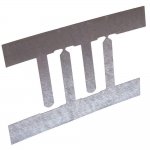Hubbel/Raco sells a single gang metal rework box with expandable "ears" on the sides which are pulled out be a screw on the outside of the box. I believe it's part #506.
Using the cut out template you end up with an opening that is approximately 1/4" wider on each side, this allows for the screw mechanism.
A mid size cover will cover the opening but it's a code violation to have that much open space around the box.
Any suggestions on dealing with the void?
Seems odd that one would have to patch drywall when using a product that's intended for rework.
Anybody ever use these?
Using the cut out template you end up with an opening that is approximately 1/4" wider on each side, this allows for the screw mechanism.
A mid size cover will cover the opening but it's a code violation to have that much open space around the box.
Any suggestions on dealing with the void?
Seems odd that one would have to patch drywall when using a product that's intended for rework.
Anybody ever use these?



